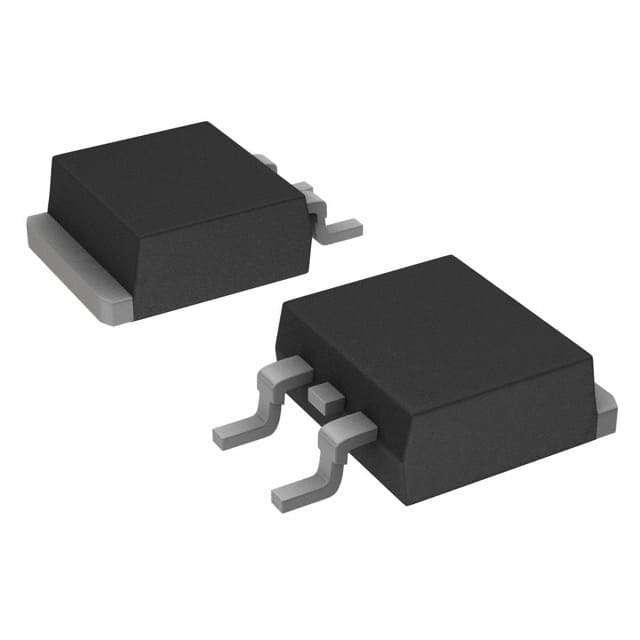Viz Specifikace pro podrobnosti o produktu.

VS-18TQ045STRRPBF
Introduction
The VS-18TQ045STRRPBF is a diode belonging to the category of Schottky rectifiers. This entry provides an overview of its basic information, specifications, detailed pin configuration, functional features, advantages and disadvantages, working principles, detailed application field plans, and alternative models.
Basic Information Overview
- Category: Schottky rectifier diode
- Use: Used in power supply applications, voltage clamping, and reverse polarity protection.
- Characteristics: Low forward voltage drop, high current capability, fast switching speed.
- Package: TO-263AB (D2PAK)
- Essence: Efficient rectification and voltage clamping.
- Packaging/Quantity: Available in tape and reel packaging with varying quantities.
Specifications
- Voltage Rating: 45V
- Current Rating: 18A
- Forward Voltage Drop: Typically 0.55V at 9A
- Reverse Leakage Current: Maximum 500µA at 45V
- Operating Temperature Range: -65°C to +175°C
Detailed Pin Configuration
The VS-18TQ045STRRPBF follows the standard pin configuration for the TO-263AB package: 1. Anode 2. Cathode 3. Not connected (Tab)
Functional Features
- Fast switching speed for efficient operation in high-frequency applications.
- Low forward voltage drop minimizes power loss and heat generation.
- High current capability enables use in power supply and high-current circuits.
Advantages and Disadvantages
Advantages
- Low forward voltage drop improves energy efficiency.
- Fast switching speed allows for high-frequency operation.
- High current capability supports diverse application scenarios.
Disadvantages
- Higher cost compared to standard silicon rectifiers.
- Sensitive to overvoltage conditions due to lower reverse breakdown voltage.
Working Principles
The VS-18TQ045STRRPBF operates based on the Schottky diode principle, utilizing a metal-semiconductor junction to enable low forward voltage drop and fast switching characteristics. When forward-biased, it allows current flow with minimal voltage drop, making it suitable for high-efficiency rectification and voltage clamping applications.
Detailed Application Field Plans
Power Supply Applications
The diode can be used in various power supply designs, including switch-mode power supplies and DC-DC converters, where its low forward voltage drop and high current capability contribute to improved efficiency and performance.
Voltage Clamping
In voltage clamping circuits, the diode protects sensitive components from overvoltage conditions by quickly conducting excess voltage away from the circuit, safeguarding against damage.
Detailed and Complete Alternative Models
- Alternative Model 1: SS34
- Category: Schottky rectifier diode
- Characteristics: 40V, 3A, SMA package
- Alternative Model 2: SB560
- Category: Schottky rectifier diode
- Characteristics: 60V, 5A, DO-201AD package
In conclusion, the VS-18TQ045STRRPBF Schottky rectifier diode offers efficient rectification and voltage clamping capabilities, with its low forward voltage drop and high current capability making it suitable for various power supply and protection applications.
Word Count: 443
Seznam 10 běžných otázek a odpovědí souvisejících s aplikací VS-18TQ045STRRPBF v technických řešeních
What is the maximum forward voltage of VS-18TQ045STRRPBF?
- The maximum forward voltage of VS-18TQ045STRRPBF is typically 0.55V at 18A.
What is the reverse recovery time of VS-18TQ045STRRPBF?
- The reverse recovery time of VS-18TQ045STRRPBF is typically 35ns.
What is the maximum reverse voltage rating of VS-18TQ045STRRPBF?
- The maximum reverse voltage rating of VS-18TQ045STRRPBF is 45V.
What is the operating temperature range for VS-18TQ045STRRPBF?
- The operating temperature range for VS-18TQ045STRRPBF is -55°C to +175°C.
What are the typical applications for VS-18TQ045STRRPBF?
- VS-18TQ045STRRPBF is commonly used in power supplies, inverters, and motor control circuits.
What is the package type of VS-18TQ045STRRPBF?
- VS-18TQ045STRRPBF comes in a TO-220AB package.
Does VS-18TQ045STRRPBF have overcurrent protection?
- Yes, VS-18TQ045STRRPBF has built-in overcurrent protection.
Is VS-18TQ045STRRPBF suitable for high-frequency applications?
- Yes, VS-18TQ045STRRPBF is suitable for high-frequency applications due to its fast recovery time.
What is the typical junction-to-case thermal resistance of VS-18TQ045STRRPBF?
- The typical junction-to-case thermal resistance of VS-18TQ045STRRPBF is 3.5°C/W.
Can VS-18TQ045STRRPBF be used in automotive electronics?
- Yes, VS-18TQ045STRRPBF is suitable for use in automotive electronics due to its rugged construction and wide operating temperature range.

